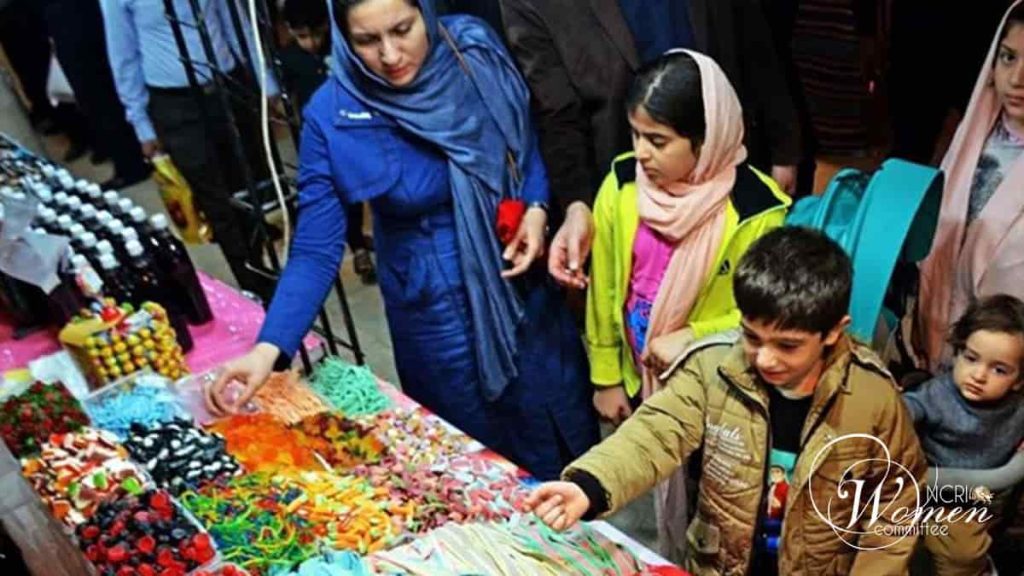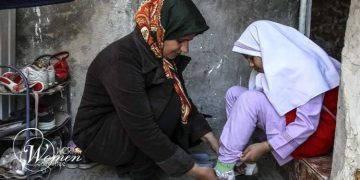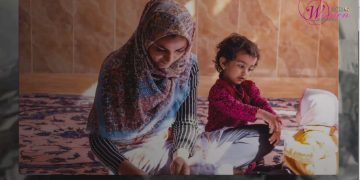The Economic Situation of Women in Iran: The Impact of Inflation and Rising Prices on Purchasing Power Ahead of Nowruz
Nowruz and the Iranian New Year began on March 20, 2025. As Iran’s most important national celebration, Nowruz is traditionally a time when families spend money on essentials, new clothing, and food. However, this year, Iranian women faced unprecedented economic challenges in the lead-up to the holiday.
Unbridled inflation, the constant surge in prices, and the devaluation of the national currency have drastically reduced purchasing power—especially for women—making daily life increasingly difficult, particularly for those in the middle and lower classes. Women who manage household finances and are responsible for meeting their families’ daily needs face mounting pressure. This burden is even heavier for women who are the sole heads of their households—many of whom belong to the poorest segments of society—shouldering all family responsibilities alone without access to suitable employment. The situation has become so dire that some patients with chronic illnesses are selling their allocated medications, while others have resorted to selling their organs just to survive.
Women traditionally play a key role in preserving Nowruz customs, such as buying new clothes and preparing the Haft-Seen table. Yet this year, soaring prices have turned these rituals into major struggles. Meanwhile, widespread government corruption—including the daily smuggling of 20 million liters of oil out of the country—has further drained national resources and deepened the crisis.
Even the regime’s media has acknowledged the dire situation. The IRNA state news agency wrote: “The holiday shopping season in Tehran hasn’t turned out as expected. Stores are not packed with crowds, shoppers carrying bags, excited children in new clothes, and exhausted shopkeepers overwhelmed with customers. A woman passes by the shops empty-handed. Her eyes are fixed on the street vendors. She says, ‘I wish I could go and buy all of this—it’s New Year’s Eve. But I’ve just come to look. I love the market buzz, but shopping takes money—a lot of money. And right now, there’s no money in my pocket.’” (IRNA – March 16, 2025)

Iran’s Economic Crisis and Its Impact on Women
Inflation and Rising Prices
In recent years, Iran has faced severe inflation—an economic crisis so overwhelming that it has made it nearly impossible for people to afford even the most basic necessities, such as food, clothing, housing, education, and healthcare.
According to a report by the Statistical Center of Iran, the inflation rate in the Iranian year 1403 (March 20, 2024, to March 20, 2025) surpassed 40 percent, with the prices of essential goods like food, clothing, and housing continuously climbing. As the Nowruz holiday approaches—when consumer demand typically spikes—these price hikes have intensified. For example, the price of lamb meat has exceeded 600,000 tomans per kilogram, while the price of Iranian rice has jumped from 100,000 tomans per kilogram last year to over 150,000 tomans in 1403.
The Impact of Inflation on Women’s Purchasing Power
Women—particularly those who are heads of households or responsible for managing family expenses—have been hit hardest by this economic hardship. The soaring prices and pre-holiday inflation have crushed many families, with the lower and middle classes bearing the brunt of the economic burden. (Rokna – March 11, 2025)
Women in these socioeconomic groups, who often have limited or fixed incomes, now face budgets that no longer cover basic living costs.
“Runaway inflation has plunged people into a state of crisis and deep depression. The working class, the poor, and even the middle class can no longer afford their essential expenses.” (Etemad Daily – March 11, 2025)

Government Corruption and Its Impact on the Economy
Major Embezzlement and Missing Resources
While the clerical regime and its state-controlled media continue to blame sanctions for Iran’s dire economic situation, the true root of the crisis lies in widespread corruption at the highest levels of government.
In a recent report, a media activist revealed that in the first 10 months of 1403 (March 2024 to January 2025), over 81,000 kilograms of gold were imported into Iran—but only 15,805 kilograms were actually made available in the domestic market. (Eghtesad Online – March 6, 2025)
He also stated that, optimistically speaking, the Central Bank has generated between 5 to 6 trillion tomans in revenue from selling gold coins in the market.
Although the Central Bank denied these claims and filed legal charges against the journalist, such embezzlement scandals are far from rare in the clerical regime. In an economic system tightly controlled by Supreme Leader Ali Khamenei and his Revolutionary Guard Corps (IRGC), those in power routinely plunder national wealth and resources.
One glaring example is the daily disappearance and smuggling of 20 million liters of oil from the country. Even the regime’s president, Masoud Pezeshkian, has repeatedly referenced this issue—often in an attempt to deflect blame for the country’s severe shortages of water, electricity, gas, and gasoline.
But everyone knows the truth: it is the hands of those in power behind this grand-scale theft. No ordinary fuel smuggler or porter could possibly move 20 million liters of oil out of the country every single day.

The Impact of Corruption on Inflation and Rising Prices
Corruption and mismanagement of national resources have fueled a surge in liquidity and rampant inflation. When national wealth is plundered, the government resorts to printing more money to cover budget deficits—further driving up prices.
Women, especially those in low-income jobs or engaged in self-employment such as street vending, are among the hardest hit by this vicious economic cycle. Mohammad Bahreinian, a regime-affiliated researcher, reported that 42.5% of employment in Iran is categorized as self-employment. Many women working in these sectors earn meager incomes rapidly eroded by inflation.
Bahreinian stated: “Data from the International Labour Organization reveals just how far behind we are. Compared to developed and developing countries, the rate of self-employment in Iran is both shocking and shameful. Over 31 years the ILO’s 2022 estimates show that 42.5% of employment in Iran has been based on self-employment, which is alarming. This figure is a troubling indicator of our economic inefficiency and inability to develop and create stable jobs for the labor force.” (Khabar Online – March 19, 2025)
The Impact of Shrinking Purchasing Power on Women’s Lives
Economic Struggles for Women Ahead of Nowruz
On the eve of Nowruz (the Persian New Year), Iranian women faced mounting financial pressures made worse by soaring inflation, rising consumer prices, and declining purchasing power. These challenges have significantly hindered their ability to observe traditional New Year customs.
One long-standing Nowruz tradition is buying new clothes for family members—a responsibility that often falls on women. However, due to the rising cost of clothing, many women can no longer uphold this practice. Even purchasing essential clothing items has become a challenge.

Akbar, a children’s clothing vendor at Tehran’s bazaar, remarked: “Our number of customers has dropped by around 40%. People are struggling even to buy basic clothes.”
Mohammad, who sells women’s clothing in eastern Tehran, echoed the concern: “The situation in the clothing sector is deeply troubling. People can’t even afford to buy the essentials anymore.” (Asr-e Iran – March 18, 2025)
Sweets and nuts—traditionally essential items for Nowruz hospitality—have also become unaffordable for many. Reza, a seller of nuts and dried fruit, noted a 40% drop in customers, adding: “People are only looking for the bare minimum.”
Abbas, who runs a confectionery in Tehran, reported: “We’ve lost about 60% of our customers. People simply can’t afford to buy sweets anymore.” (Asr-e Iran – March 18, 2025)
This situation places an even heavier burden on women, who are typically responsible for procuring these holiday items.

The Impact on Women’s Quality of Life and Well-Being
The decline in purchasing power has severely diminished the quality of life for Iranian women. Many are now unable to access basic healthcare, education, or recreational services. According to a report by Etemad Online: “Runaway inflation has plunged people into a deep state of crisis and depression. Lower-income and middle-class families can no longer afford even their most basic needs.” (Etemad Online – March 11, 2025)
This erosion of purchasing power goes beyond material hardship. The constant stress of being unable to provide for their families is taking a toll on women’s mental health. Many sacrifice their own needs to cover the bare minimum for their children. A report by IRNA on pre-Nowruz shopping reveals: “Families prioritize buying for their children, and only if there’s any money left, do they think about themselves.” (IRNA – March 16, 2025)
Such sacrifices have intensified what is often called the “feminization of poverty” and have deepened gender inequality. As Etemad Online observed: “The economic situation has reached a point where the poverty line is now the same for both lower and middle-income groups—both are living at nearly the same subsistence level.” (Etemad Online – March 11, 2025)
This alarming trend reflects the growing breadth and severity of the economic crisis.
Rising Prices of Basic Goods and Their Impact on Women
According to official statistics, the prices of some essential food items have surged by as much as 220 percent: potatoes by 217%, eggplants by 122%, tomatoes by 116%, split peas by 108%, and pinto beans by 104%. This steep inflation places a heavy burden on women, who are often responsible for cooking and providing meals for their families.
Mohsen, a fruit vendor in Tehran’s Monirieh district, said: “In a few days, sales for Nowruz fruit baskets will begin, and prices will likely be 10 to 15 percent higher than they are now. The numbers suggest that customer turnout ahead of the New Year will be half of what it was last year. In previous years, we saw a surge in customers during Ramadan and the month of Esfand, but not anymore.” (Asr-e Iran – March 18, 2025)
Women’s Employment and Informal Work
A large number of Iranian women are engaged in informal or self-employment, ranging from street vending to home-based work. However, the income from these jobs fails to keep pace with inflation, leaving many struggling to make ends meet.
During the Nowruz shopping season, street vendors—many of whom are women and men from low-income backgrounds—fill the markets with inexpensive goods.
“The market belongs to the street vendors. Everyone has spread out a cloth in some corner, displaying low-cost items. Business is brisk… It seems people prefer buying from these vendors. Even storeowners, trying to offset declining sales, have set up stalls in front of their shops and put up signs that read ‘Sale!'” (IRNA – March 16, 2025)
Yet even this type of income is not enough for many women, and most remain below the poverty line. Field reports from Tehran’s popular shopping areas, such as Tajrish and Haft-Hoz markets, reveal a deep sense of frustration among female shoppers. One mother in the Salsabil market shared: “Prices are too high. For what we’re paying, the quality just doesn’t measure up. People are just browsing, asking prices, and then leaving. I rarely saw anyone buying anything. Most left the market empty-handed—it felt like they were just there to look, not to shop.” (Iran Newspaper – March 16, 2025)
Women on the Frontlines of Change
In the new Iranian year, women across the country are grappling with severe economic hardship rooted in the corruption and incompetence of the ruling regime. Soaring prices, unbridled inflation, and the looting of the nation’s wealth and natural resources by a government intent on enriching itself have plunged the majority of Iranians below the poverty line. Women—many of whom work in low-paying jobs or have no stable income—bear the brunt of this vicious cycle.
The clerical regime, which persists in repression, plunder, and bloodshed until its final breath, has shown no intention of improving conditions. Its sole concern is the preservation of power. Ending this dire situation and building a better future is only possible by dismantling this corrupt system and replacing it with a just and accountable government.
The only viable path out of this crisis is through a united, organized struggle to overthrow the regime. Women—the backbone of families and society—hold a key, trailblazing role in this movement. By joining the Resistance Units and leading protests and uprisings, they are paving the way toward liberation and lasting change.
























